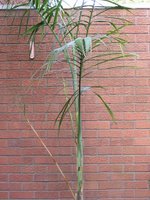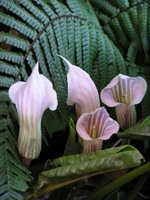
Chamaedorea Radicalis is one of my "mystery why no one else seems to grow it" palms, the other being C.Microspadix.
Hand on heart, I've only seen this palm get a mention three times anywhere.
Once in the Palm Centre catalogue, from where I bought mine, once on the website of an American enthusiast who was creating a mini forest of them and here on this Blog.
This really puzzles me, because C.Radicalis must rate as the best palm ever for a moist shady spot in the garden.
I might add, that for a few years at least, it also makes a very good house/conservatory palm.
Native to Mexico, where it grows as an understory palm in tropical rainforests, C.Radicalis has turned out to be extremely hardy, shrugging of temperatures down to -10c in my garden.
It's also turned out to be one of the easiest palms to look after, requiring little more than a rich, moisture retentive but well drained soil to succeed.
Although it has something of a reputation for slow growth, plenty of fertilizer during the growing season will speed things up a tad.
It's also unusual, in that it will flower when still a young plant but you need male and female plants to get any berries.
When I bought my Radicalis, it was some two feet tall, now, at just seven feet it's too big to bring indoors, so it lives outside behind the kitchen against a North facing wall.
This is actually a fairly open position, so it does get a decent amount of light.
It seems to like this spot, because this year it's got a bit excited and put on four new leaves and three flower spikes, normaly it's two leaves and two flower spikes, perhaps I've done something right at last.
There's one thing I've learned about palm growing, or for that matter any plant which I think is important, be prepared to experiment, particularly with regards to siting your plant, you might well be surprised at what a little change can do.
Despite my glowing rhetoric, C.Radicalis can have a few problems.
Indoors or out, Red Spider Mite raises its ugly head.
Indoors I give it a dose of "Provado", while outdoors a regular, heavy misting with plain water keeps them down.
Wind can also do some damage, fraying the leaf tips and making them look a little unsightly.
Strong sunlight will also cause damage, giving the leaves a bad case of sunburn, early morning or late evening sun is best.
C.Radicalis is the only palm that I protect for the Winter and this is just a throw over of fleece to give the leaves some protection from the wind and a cover for the roots which are growing well above the surface of the pot.
Despite the niggles mentioned above, this really is a beautiful palm, graceful and easy to look after, well worth the effort. Posted by: Mike.
Note: For a more comprehensive explanation of how I plant my palms, see my June blog:

In a world where Arisaemas are seen by many as ugly, I've even heard them described as evil looking, Arisaema Candidissimum shines like a beacon in the darkness.
Since its discovery in 1914, it's become one of, if not the, most popular plants of the genus.
Every one who sees it, seems to fall in love with it even if they're not Arisaema fans generally.
When you've seen one in flower it's easy to see why.
You certainly couldn't describe the flower ( spathe ) as brash, but with their almost porcelain like whiteness suffused with pastel pink stripes, they have almost a hypnotic effect on people.
I've only ever heard two words used to describe this plant, beautifull and pretty, which just about says it all.
Fortunately for us, A.Candidissimum is a versatile plant being both hardy and easy to grow.
Allthough it isn't the only Arisaema that likes plenty of light, it's the only one I know of that will tolerate the hot afternoon sun, even if it does flop a bit.
At the moment, I have A.Candidissimum planted out in several areas of my garden.
These range from, deepish shade through to full sun from midday to about 6pm.
In deep shade, they perform poorly, being very economical with flowers and leaves.
In light shade to full sun, they really get into their stride, putting up numerous flowers with leaves up to 14 ins across at their widest point.
I should point out, that you might get this one year but not the next.
This is because Arisaemas have quirks, one of which is the ability to adjust its growth to the energy its expended and the prevailing conditions.
So, if growing conditions are good one year, you could get plenty of flowers and a good seed set.
However, the following year, good growing conditions or not, could see few flowers and no seed set at all.
This is the way the plant rebuilds all the energy expended the previous year on flowering and seed setting.
Very neat.
To sum up, A.Candidissimum, is a superb plant for expert or newcomer alike.
Planted in light shade to full sun and given a good feed and plenty of water when in growth, A.Candidissimum will prove to be one of the best plants for the exotics lover to grow. Posted by: Mike.
Arisaemas, are interesting and complex members of the Aroid family.
Usually the preserve of the alpine and woodland plant enthusiast, the renewal of interest in growing exotics, has seen Arisaemas "Come in from the cold" with more people than ever growing them.
In the past twenty years or so, there has also been a flurry of new introductions, bringing even more species to the attention of the exotics enthusiast.
Although they're distributed widely throught the world, here in the West, we fare poorly, there being just a few noteworthy species.
It is the Far East that provides us with the bulk of the species we grow, including those known as "The Whiplash Arisaemas", with the Himalaya, China, India and of course Japan all being home to many fine plants.
Usually regarded as woodland plants, given some light or dappled shade and moisture, they'll grow almost anywhere.
I've seen them growing on the shady side of rockeries and I've grown A.Triphyllum and A.Consanguineum in a part shaded scree bed, with A.Candidissimum in a sunnier spot.
There are some doubts, about the hardiness of some of the plants I mention here, but in my garden they've all proved to be hardy down to -10c.
Deep planting and a heavy precautionary mulch, takes care of the winter.
However, early risers might get nipped by frost.
For gardeners who live further South than Birmingham, I'd expect all these species to be hardy, further North, the opposite and some may well need lifting and storing for the winter.
Good species to start with are, A.Amurense, A.Candidissimum, A.Consanguineum, A.Costatum, A.Flavum, A.Triphylum and A.Jacquemontii.
Species which may need protection or lifting include, A.Elephas, A.Engleri, A.Griffithii, A.Speciosum, A.Sikokianum, A.Tortuosum, A.Nepenthoides.
There are many more species available, but I think there's enough here to keep anyone going for a year or two.
Growing Arisaemas in pot's, gives you the opportunity to get a close look at these unusual plants.
It's also the best way of bulking up small corms which have been grown from seed or retrieved from around parent plants.
Deep crock pots are the best to use, with those known as "Long Toms" being ideal.
Always use pots which are large enough to give the corms room to grow.
Flowering size corms, should be planted approximately two thirds of the way down the pot, small corms, about the same or slightly less.
Remember, Arisaemas root from the top.
Most people say you should use an acid to neutral compost, but I've always grown them in whatever I've got available at the time.
Commercial orchid compost, as sold by Levingtons and J.Arthur Bower is o.k. but extra bark chips or Perlite should be added to improve the drainage.
Also good is one part coir, one part well rotted manure and one generous part of bark chips or Perlite.
To these mixtures, I also add long life fertilizer and charcoal pieces.
Far more important than which compost you use, is drainage, this must be excellent.
The corms of some species, seem to be more prone to rotting than others and excess water hanging around should be avoided at all costs.
At the risk of repeating myself, always err on the side of too much drainage rather than too little.
I don't use grit or gravel in my Aroid compost's, nor do I rest the corms on the stuff.
Aroids have a relatively soft outer skin and it is easily punctured by sharp edges.
Stick to Perlite or bark chips.
Once potted, they should be kept in a cool shaded area.
Don't water the pots when the corms are dormant, wait until you see the growing point emerging through the soil, then give them a very modest amount of water.
As growth continues, move the pots into better light but avoiding strong sunlight. Give more water and start adding fertilizer.
For flowering size corms, I use liquid tomato fertilizer, for bulking up small corms, I use liquid high nitrogen fertilizer.
I dilute my fertilizer to one third full strength and give them a feed at every watering.
It's beneficial, to keep the plants growing for as long as possible but once the leaves begin to die down, stop watering and feeding immediately.
When corms are fully dormant, return the pots to the cool shaded area again.
There are two ways of planting out Arisaemas, or for that matter, any bulb or corm.
The method you use, depends on whether you want to retrieve offsets.
If you're not bothered, use method one.
If you want to retrieve offsets, use method two.
First, choose your spot where the corms are to be planted.
Dig a fair sized diameter hole, at least 9 inches deep.
Don't skimp on this it's important.
Really loosen the soil at the bottom, excess water must drain away.
If you want to put anything beneath the corm, use Perlite or bark.
Refill the hole, with a mixture of soil, well rotted manure if available and long life fertilizer.
I normally put in a marker stick at this point so I know where the corm is.
If you're planting corms in the shade of say, a palm or tree fern, then do it when they're dormant and try not to do to much damage to their roots.
Even better, plant them at the same time as the shrub, palm, tree fern or whatever.
At this depth, the corms should be o.k. through the winter.
If your a bit unsure though, simply cover with a heavy mulch and that should do the trick.
This is the method I've used, for planting bulbs and corms, for well over twenty years.
It makes use of the plastic baskets that you grow pond plants in.
Its one great advantage is, that it makes collecting offsets very easy.
You simply have to dig down to the basket and lift it out, complete with offsets in situ.
The only downside, is that you can't really use it around other plants, as the roots grow through the basket making it difficult to retrieve without causing any damage.
As with method one, dig a deep good sized hole.
Place the basket in the bottom, put the corm in and finish of as method one.
(I usually make a couple of handles, using some strong wire which, when attached to the basket, make lifting it out even easier.)
That's all there is to it.
Growing Arisaemas from seed is easy, other than a soak in water for a day or two, they need no special preparation.
It also gives you the opportunity, to grow species which are expensive to buy as corms, or are not easily available commercialy.
The downside of course, is that you have to grow them on to flowering size yourself, between three and five years usually, which probably doesn't appeal much to todays "instant gardener".
Autumn through to Spring are the best sowing times and all that you need, are your seed, some pots and a well drained mix of your favourite seed or potting compost.
Soak the seed for a day or two, giving them a swish around in fresh water occasionaly.
Fill the pots and plant the seed, I usually put mine in at between a quarter and half an inch deep, depending on the size of the seed.
Place the pots in a tray and fill with water.
When the pots feel heavy, remove them and allow to drain.
Cover the pots with plastic bags or put them in a cold frame, unheated propagator or on shady window sill.
Germination is erratic and can take several weeks.
When the first seedlings show, remove the cover and move into better light.
I keep mine in the same pots for two years, which gives the young corms a chance to put on a bit of growth before moving them on.
As the seedlings grow, feed on high nitrogen fertilizer.
Don't over water, this can be lethal, the compost should be just moist.
After three years, I switch to liquid tomato fertilizer to encourage the corms to flower.
When they've flowered once in their pots I plant them out.
To grow on from corms, is even easier.
You can leave the corms around the parent plant to build up to a decent size or you can remove them when they're small.
Which ever way you choose, grow them on as outlined above.
You can, actually "force" the corms, so that you cram two years growth into one but this is a bit involved so I'll leave it out. Posted by: Mike.
Given a bit of care and attention, they're very rewarding plants, which from spring to early summer will definitely add that "Jungle Look" to your garden.




